Fujifilm X-M1 Review
Fujifilm X-M1 Introduction
The Fuji X-M1 is the baseline Fuji mirrorless, featuring their own unique X-Trans CMOS sensor paired with a second-generation EXR II processor. Its 16 megapixels APS-C sensor with a 6x6 color-filter array requires no anti-alias filter for maximum sharpness without being subject to moire artifacts.
The 1.5X crop sensor of the X-M1 can capture full-resolution images at 5.6 FPS or full 1080p HD video at 30 FPS using a fast EXR processor. It has a broad ISO 100-25600 sensitivity range and full manual-controls, plus a hot-shoe for additional lighting. There is a 3" LCD with 920K pixels that tilts for framing but no EVF, nor provision for an add-on one.
This mirrorless supports all Fujinon X-mount lenses, plus third-party ones. It can use the rear control-dial to set aperture for those lenses without an aperture-ring. Manual focus is performed via a fly-by-wire ring on all Fuji lenses.
Fuji's own X lens mount has a rather short flange distance. This makes it easier to design high-quality lenses and lens-mount adapters, including one made by Fuji for the Leica M-mount. Fuji launched a total of twelve lenses so far, mostly bright prime lenses and some zooms. XF lenses have their own aperture-rings while XC ones do not.
The built-in WiFi function on the X-M1 makes sharing of images right from the camera a breeze while a built-in flash is included in place of where the EVF is on the X-E1.
This digital camera review analyses the usability, performance and image quality of the Fuji X-M1.
Fuji X-M1 Features
Sensor
- 16 Megapixels CMOS sensor
- X-Trans 6x6 Color-Filter Array
- No Anti-Alias filter
- 1.5X Crop factor (APS-C)
- 3:2 Aspect ratio
- Fuji XF lens mount
- Dust-Reduction
Exposure
- ISO 200 to 6400 sensitivity range, 1/3 EV steps
- ISO 100, 12800 and 25600 expansion, JPEG only
- Auto ISO, Selectable maximum from 400 to 6400
- ISO Bracketing, 3 frames, 1/3-1 EV steps
- 1/4000-30s Shutter-speeds, 1/3 EV steps
- Bulb exposure, maximum 1 hour
- PASM Exposure modes
- Multi-Segment, Spot and Average metering
- Exposure-Compensation, ±3, 1/3 EV increments
- AEB, 3 frames, 1/3-1 EV increments
- 100%, 200% or 400% Dynamic-Range
- Dynamic-Range Bracketing, 3 frames
- Flash-Compensation, ±2, 1.3 EV steps
- Auto, Forced, Slow-Sync, Rear-Sync, Wireless and Off Flash modes
Image Parameters
- Automatic, 7 presetsSunny, Shade, 3 Fluorescents, Incandescent, Underwater, Kelvin and Custom WB
- WB fine-tuning along 2 axis in 19 steps
- Film Simulation: Provia, Velvia, Astia, B&W, Sepia
- Film Simulation Bracketing, 3 frames
- Adjustable Noise reduction, Color, Sharpness, Highlight Tone, Shadow Tone, 5 steps each
- Optional Long-Shutter noise reduction
Focus
- Single-shot or Continuous autofocus
- Manual-focus (MF), Electronic Magnification
- Automatic or Manual focus-point selection
- Optional Face-Detection
- Optional Focus-Peaking
- Optional MF-Assist view
- Optional AF-Assist lamp
- Fly-By-Wire focus-ring on lenses
Drive
- 5.6 FPS Continuous Drive
- 30 JPEG or 10 RAW Buffer
- Self-timer, 2s or 10s
Video
- 1920x1080 @ 30 FPS Video
- 1280x720 @ 30 FPS Video
- AF-S, AF-C or MF
- Quicktime H.264 format
- Stereo sound
Display & Viewfinder
- 3" Tilting LCD, 920K Pixels
- Optional Live-Histogram
- Optional Framing-Guides, 3 types
Output Processing
- 3:2 Native aspect ratio
- 16:9 and 1:1 cropped aspect ratios
- 16, 8 and 4 megapixels modes
- JPEG, RAW, RAW+JPEG capture
- 2 JPEG Compression levels
Misc
- Dual control-dials
- Traditional mode-dial
- Customizable Fn button
- Standard Hot-Shoe
- Built-In popup flash
- Lithium-Ion battery
- SDXC memory
- Built-in WiFi
- HDMI (1080i) output
- USB 2.0 connectivity
Fujifilm X-M1 Usability - How easy is it to use?
While the X-M1 offers the same sensor as the premium X-Pro1, it does so in a more compact and conventional design, at least for a mirrorless camera. The X-M1 offers an unusual mix of entry-level and advanced features. Like other entry-level cameras, it lacks any kind of viewfinder, yet it includes dual control-dials and a hot-shoe.
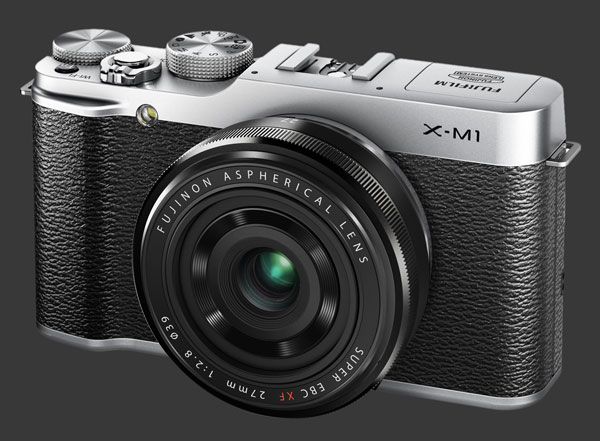
The largely rectangular body of this camera curves slightly outwards to provide a small grip on its textured front. The casing is almost entirely made of plastic which means it tends to be rather slippery. Still, the Fuji X-M1 feels solid but light. Even the LCD hinge which is made of metal appears sturdy.
The front of this mirrorless is almost bare. Besides the requisite lens-mount and corresponding release button, there is an AF-assist lamp and a logo. The top plate is fully-used. Starting at the left, there is a small popup flash, next a hot-shoe and the built-in stereo microphone.
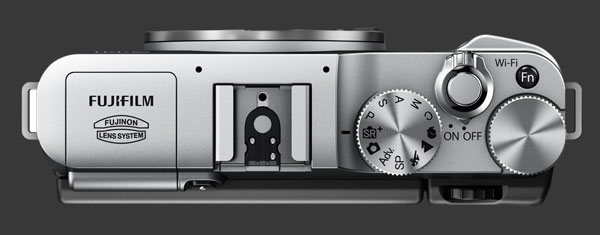
As the top-plate curves downwards, its surface gets busy with a number of controls. A traditional mode-dial with 12 positions, including the usual PASM modes, has strong detents and will not move accidentally. To its right, and aligned with the front-edge of the camera, there is a smallish two-stage shutter-release surrounded by a rotating power-switch. The release has a moderate amount of travel with a soft halfway point. Since the X-M1 is not focus-priority, this makes it possible to take a shot before autofocus has locked.
At the front-right corner of the top-plate is the only customizable button on this mirrorless. In Playback mode, it initiates the WiFi function, while in Capture mode it can be assigned to one of 15 functions. A logical choice is ISO. However, this is the only place to access Depth-of-Field preview. At least Fuji makes it easy to change the assigned function. Just keep the Fn button pressed for 3 seconds and a menu of options appears.
The upper control-dial is found just behind the small Fn button. This one controls EC outside of Manual mode. Unfortunately, this dial is unmarked and its detents are too soft. This is probably the only troublesome design-flaw of the X-M1 and makes it easy to accidentally affect exposure without noticing. In Manual mode, it controls shutter-speed.
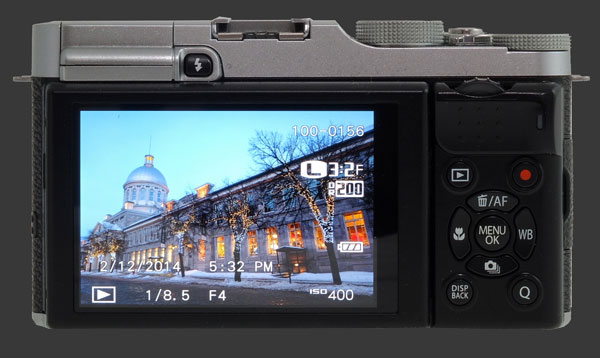
All the remaining action is found on the back of this camera. A large 3" LCD with 920K pixels dominates the view. It is mounted on a hinge so that it can tilt up or down 90°. The view is nice and sharp with an excellent viewing angle. This LCD has a good refresh-rate and maintains a bright view even in low-light. The display is unfortunately not Exposure-Priority so the preview is often misleading. There is an optional Live-Histogram which is based on the shown preview and therefore of little use.
Above the display there is a mechanical release for the built-in flash. It never pops up automatically which is exactly how it should work on any camera as flash-use should be decided upon by the photographer. That flash is rather small with a Guide Number of 7. A standard hot-shoe is available to accommodate an a more powerful and independently-powered unit.
To the right of the LCD, there are a good number of buttons for an entry-level mirrorless. High up on the body, there is a clickable control-dial which is vertically mounted. Turning it controls the main exposure-parameter in A, S or M mode. Clicking it activates MF-Assist during Manual Focus. It does nothing otherwise. A small textured area below the dial serves as a thumb-rest.
A Playback and Video-Record button are found just below the thumb-rest. The former toggles Playback mode while the camera is powered on. The latter starts and stops video capture. This button is recessed to prevent accidental use. It is worth noting that there is no Video mode on the X-M1. Recording starts a full second or even two after pressing the button, depending if using MF or AF for video capture.
The 4-way controller with central OK/Menu is made of 5 separate buttons. Each button is assigned a function in Capture mode:
- Up: AF point selection. Only works if the manual AF-point mode is active.
- Right: Presents a vertical menu of WB options. Pressing Right again from there enters the WB Fine-Tuning interface with a step to measure Custom WB.
- Down: Brings up a two-level menu to select Drive modes: Single, ContinuousHigh at 5.6 FPS or Low at 3 FPS., AEB, ISO Bracketing±1, 1/3 EV steps, Film Simulation Bracketing or Dynamic-Range Bracketing.
- Left: Selects between normal and Macro mode. Note that this is a hint to the camera and a macro lens is required for macro photography.
The last two buttons are DISP/BACK and Q right below the 4-way controller. The display buttons cycles over display modes with one being customizable. This mode offers a choice of grid lines, including those to mark the HD 16:9 video-recording area which is the only way to frame before filming.
Q brings up a status grid of 15 editable items among 16. This offers a relatively quick way to control the Self-Timer, Stabilization and Flash mode. Note that enabling stabilization only works if the mounted lens is optically stabilized.
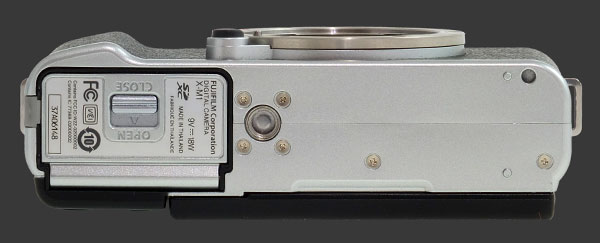
The bottom of the Fuji X-M1 has a metal tripod mount which is neither in-line with the optical axis nor with the center of gravity of the camera. There is also a single compartment door which gives access to both the SDXC card and the Lithium-Ion battery. Since the door is really close to the tripod mount, it is not possible to change memory or battery while the camera is on a tripod or even just fitted with a quick-release plate.
Overall, the Fuji X-M1 handles nicely while offering more controls than other entry-level mirrorless cameras. Having dual control-dials is rare in this camera category yet the upper-dial often results in unwanted exposure-compensation because its detents are too soft and it is unmarked. The other let-down is the display which does not preview exposure or white-balance correctly. Regardless of these two issues, the X-M1 is easy and relatively efficient to use.
Fujifilm X-M1 Performance - How well does it take pictures?
Performance starts with image quality, which is the criteria used as the foundation of our digital camera ratings. Ergonomic issues may get in the way, but in the end, image quality counts the most. For an ILC, image quality greatly depends on the lens used. While color, noise, exposure and dynamic-range are properties of a camera, distortion, vignetting and chromatic aberrations are properties of the lens. Sharpness and contrast depend on the weakest link. That is, a camera cannot capture more details than a lens lets through. Conversely, it is quite possible for a lens to transmit more details than a sensor can capture.

Image Noise & Details
The Fuji X-M1 produces images of exceptional quality. It exceeds the quality of almost all cropped-sensor DSLR throughout its range of ISO sensitivities, making it even comparable to some full-frame models. Image noise is inexistent all the way to ISO 1600 and becomes barely detectable at ISO 3200. ISO 6400 shows a slight increase with minimal impact on fine-details. ISO 12800 is visibly noisy yet mid-size prints remain possible. ISO 25600 shows another jump in image-noise yet can surprisingly pull-off a small 4x6" in emergencies.
While we know the unique X-Trans sensor delivers in terms of sharpness from the X100S review, output was not so sharp with the X-M1 since the only lens available for testing was the Fujifilm Fujinon XC16-50mm F/3.5-5.6 OIS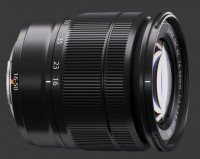
Fujifilm Fujinon XC16-50mm F/3.5-5.6 OIS. Even so, softness is only visible when viewed at 100% and would barely make a difference in maximum print size.
Sharpness is controllable in 5 levels. Things start from a very soft to over-sharp, so each step is quite coarse. The default level leaves a little softness and one above adds a touch of sharpness with minimal artifacts. The noise-reduction applied is more conservative on the X-M1 than on the flagship X-E2 which makes the former's output more usable at high-ISO and much closer to that of the original X-E1.
There are 5 levels of noise reduction with not much variation between steps. Even at the lowest setting, noise-reduction is still applied which is particularly noticeable from ISO 3200 up. While there is no way to turn-off noise-reduction in-camera, users may choose to shoot RAW and perform their own. This is available only for the standard sensitivity range of the X-M1 which goes from ISO 200 to 6400.

Color & White Balance
Color accuracy of the X-M1 is very good. Hues are realistic with different Film Simulation modes mostly affecting saturation. The standard Provia mode slightly exaggerates saturation which can be improved by setting Color to -1. Alternately, one can start with Astia which provides a softer and less contrasty look.
Automatic White-Balance is dependable under typical conditions. It handles natural light very well yet struggles more than usual under artificial lighting, leaving a yellow cast. It really depends on the exact situation but that cast can get particularly strong in low-light. The twisted issue though is that AWB is often previewed incorrectly, tricking the user into incorrectly changing settings. A Custom White-Balance option is there for difficult situations and is more accurate.
Exposure
The Multi-Segment metering system of the X-M1 is extremely reliable and consistent. It is highly conservative which results in darker-than-usual images. It rarely blows anything but the smallest highlights, although it may not seem like it on the EVF and LCD because their dynamic-range is much more narrow than what this camera can capture.
Dynamic-Range of the X-M1 is spectacular when increased to 200% starting at ISO 400 or to 400% starting at ISO 800 which is possible all the way to all the way to 6400. This camera handles high-contrast scenes even better than most digital cameras, including top-of-the-line DSLRs.
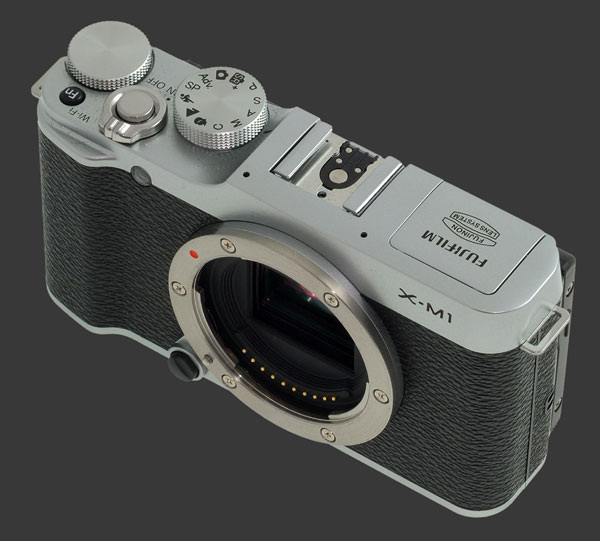
Auto Focus
The X-M1 features a first-generation of X-Trans CMOS sensor which only supports Contrast-Detect AF. This is how most mirrorless cameras focus. While it is more accurate and flexible than Phase-Detect AF used by all DSLRs, the way it works makes a fast implementation much more difficult.
Contrast-Detect AF can be performed anywhere on the sensor. When manually selecting the AF-point, the user is given 49 areas to choose. Each area is available in 5 sizes. Focus is achieved by maximizing the contrast in the selected area. For Tracking AF, a mid-size area moves freely while attempting to keep its position on the same part of the scene.
Autofocus speed is about average. It can take anywhere from ¼ to 1s for the X-M1 to lock focus or give up. Most times it does lock in about ½s which is reasonable but certainly does not cut it for moving subjects. Tracking AF is unusual as it does follow something quite well but it does not focus on it until the shutter-release is pressed half-way. This is in contrast with Continuous AF which keeps the center of the frame in focus at all times.
Speed
The Fuji X-M1 is quick and responsive. Nearly all actions occur without delay. It can shoot continuously at 5.6 FPS which is comparable to high-end DSLRs but notably slower than a number of mirrorless models. The buffer is capable of accommodating 30 JPEG images or 10 RAW files in one burst when using a fast memory card.
The following measurements characterize the performance of the Fuji X-M1:
- Power-On: About 1s. Very good.
- Power-On to First-Shot: 1¼s with MF, 2s with AF. Average.
- Autofocus: ½-1s, depending on the light. Just below average.
- Shutter-lag: Immediate with under ½s blackout. Very good.
- Shot-to-shot: 2s with AF. Slow. Just over 3/4s with MF which is good.
- Playback: About 3/4s to enter or exit. On the slow side.
- Power-Off: 2s including sensor-cleaning. Good.
- Video: 1 or 2s to start. Instant to stop. Slow.
Performance of the X-M1 is mixed. Shot-to-shot speeds are clearly its weak-point when using AF, which is also slower than average. The video-record lag is unfortunate and can cause action to be missed. The remaining performance is clearly at an acceptable level. This reinforces our earlier conclusion that this is not a camera for action photography.
The Fuji X-M1 is powered by a small proprietary Lithium-Ion battery which provides 350 shots-per-charge. This is about average and goes down quickly while reviewing images. Another battery is highly recommended not to run out unexpectedly. The small size of the battery makes it quite sensitive to cold and hardly able to shoot even half its quoted maximum as temperatures approach freezing.
Fujifilm X-M1 Conclusion
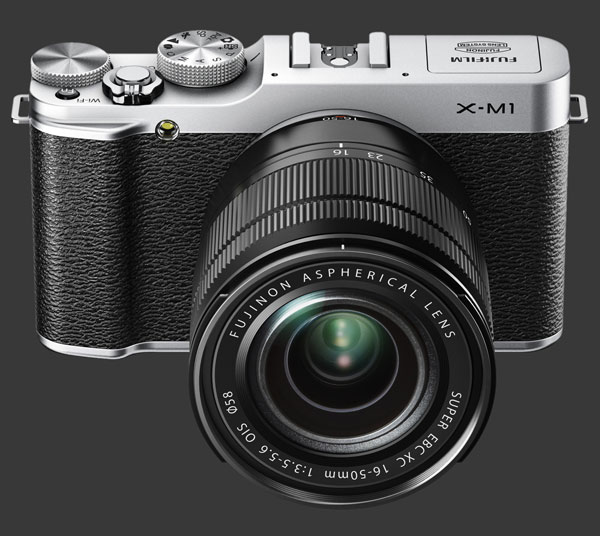
The Fuji X-M1 presents an extremely interesting offering among entry-level mirrorless cameras. Its proven 16 megapixels X-Trans CMOS sensor delivers the best image-quality in its class, matching that of digital cameras that cost considerably more. Its relatively compact body with dual control-dials and a traditional mode-dial make it more efficient to use than competing models.
Image-quality is undoubtedly the strongest point of the Fuji X-M1 with virtually noise-free output up to ISO 1600. This mirrorless can produce medium-sized prints up to ISO 12800 by retaining an impressive amount of details even at such high sensitivities. Dynamic-range is very good which helps make its metering quite reliable. Color rendition is also good. Only white-balance under artificial light poses occasional but easily-corrected issues.
While the X-M1 is generally quite responsive, this is not a fast camera. Its extremely accurate Contrast-Detect AF system is slower than its peers as are shot-to-shot times. Still, shutter-lag is nonexistent and the back-out-time is short, letting the user keep his eye on the subject and take the shot at the desired moment.
Usability is certainly better than most entry-level cameras of any kind with direct controls of a high number of functions. Its too bad the EC dial is unmarked and easily moved accidentally. The display is not Exposure-Priority either, which makes this issue harder to catch.
The most serious challenge for the Fuji X-M1 are Fujinon lenses. Fuji launched their X-mount system as a high-end offering and has been concentrating on producing lenses of exceptional quality. That quality comes at the price of increased size and weight compared to other entry-level offerings. This is rarely an issue with more professional models yet is a common consideration for buyers of entry-level cameras.
Anyone looking for top-notch image-quality from a mirrorless should have the Fuji X-M1 near the top of their list. When speed is not an issue, this digital camera can truly deliver. Fuji and third-party makers now offer a wide-range of native X-mount lenses with an emphasis on street-style photography. The unobtrusive design of the X-M1 lets photographers get close to the action while feeling unincumbered.
 |
Please Support Neocamera
All information on Neocamera is provided free of charge yet running this website is a huge endeavor. Purchases made via affiliate links found throughout the site help keep it running and up-to-date. There is no additional cost to you, so please consider buying via these links to our affilates:
If you found any information on this site valuable and did not purchase via our affiliate links, please considering donating via PayPal:
Any amount will be greatly appreaciated. Thank you for your support!
Fujifilm X-M1 Highlights
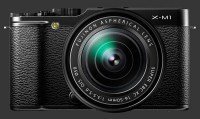
Sensor-Size: 24 x 16mm

Actual size when viewed at 100 DPI
| 16 Megapixels Mirrorless | ISO 200-25600 |
| Fujifilm X Mount 1.5X FLM | Shutter 1/4000-30s |
| Built-in Dust Reduction | Full manual controls, including Manual Focus |
| 5.6 FPS Drive, 30 Images | Custom white-balance |
| 1920x1080 @ 30 FPS Video Recording | Spot-Metering |
| 3" LCD 920K Pixels | Hot-Shoe |
| Lithium-Ion Battery | |
| Secure Digital Extended Capacity |
Updates
2024.11.18

Best 2024 Photography Gifts for Every Budget
Great gifts for photographers and photo enthusiasts selected for every budget among the best products of 2024.
2024.08.07

Eye Protection Tips for Professional Photographers
The four main considerations for professional photographers regarding eyewear.
2024.07.14

Fujifilm X100VI Review
Flagship fixed-lens compact digital camera with a 40 MP sensor and Image-Stabilization, a first for the series. Retro design featuring dual control-dials, plus direct ISO, Shutter-Speed and EC dials. Its hybrid viewfinder can switch between EVF and OVF mode.
2024.05.09

Fujifilm GFX100 II Review
Flagship 102 Megapixels Medium-Format Mirrorless Digital Camera with 8-Stop 5-Axis IBIS, 8 FPS Drive, 8K Video and 400 MP Super-Resolution capture in a weatherproof and freezeproof body with dual control-dials and dual memory-card slots.
2024.04.03

Fujifilm X-T5 Review
Newest Fujifilm flagship boasting a 40 MP APS-C sensor, 5-axis IBIS with 7-stop efficiency, 15 FPS continuous drive, 6.2K Video capture, dual control-dials and dual SDXC UHS-II slots in a sturdy weatherproof and freezeproof body.
2023.11.20

Best Digital Cameras of 2023
Find out which are the Best Digital Cameras of 2023. All the new Mirrorless Digital Cameras from entry-level to high-end professional.
2023.07.10

Fujifilm X-H2 Review
40 Megapixels APS-C Hybrid Mirrorless Digital Camera with 7-stop IBIS. Fastest shutter ever and 8K video capture. Large builtin EVF with 0.8X magnification and 5.8 MP, plus an Eye-Start Sensor. Packed with features and large number of controls in a weatherproof and freezeproof body.
2023.05.07

Sony FE 20-70mm F/4G Review
Review of the unique Sony FE 20-70mm F/4G lens. The optical zoom of this lens spans ultra-wide-angle and medium focal-length coverage, making it one of the most versatile Full-Frame lenses on the market.
2023.01.15

Huion Inspiroy Dial 2 Review
Review of the Huion Inspiroy Dial 2 tablet, a medium sized drawing surface with dual dials and customizable buttons. Connects via USB-C or Bluetooth 5.0 with Windows, Linux and Android support.
2022.12.08

How to Pack for a Photo Trip
Find out how to pack for a travel photography trip, carry your gear safely while meeting airline regulations.
2022.11.13

Best Digital Cameras of 2022
The best digital cameras of 2022. A short list of the most outstanding models in their respective categories. Choose one for yourself or as a gift.
2022.09.21

Pentax DA* 60-250mm F/4 SDM Review
Review of the Pentax DA* 60-250mm F/4 SDM, the constant-aperture telephoto zoom with the highest zoom-ratio on the market.














